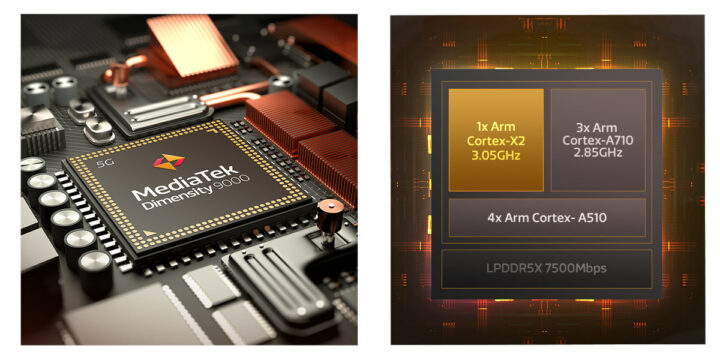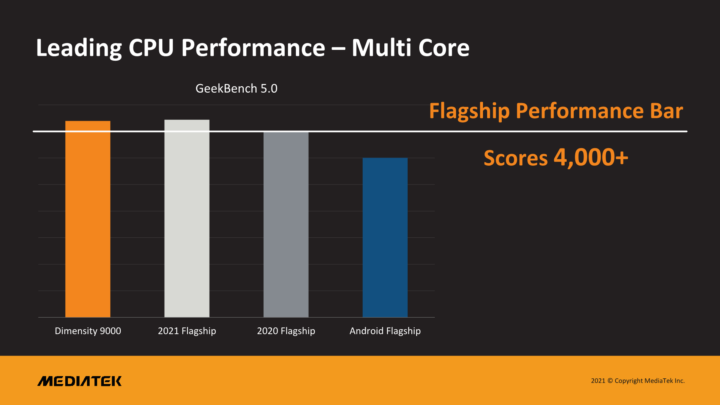MediaTek is the top mobile SoC vendor in terms of unit shipped, well ahead of the competition, but the company’s processors were mostly found in entry-level, mid-range, and “premium” smartphones, while flagship smartphones usually feature application processors from Qualcomm, Samsung, or Apple.
But MediaTek has upped the ante with the introduction of the Dimensity 9000 smartphone processor featuring an octa-core Armv9 CPU subsystem, including one Cortex-X2 core clocked at up to 3.05 GHz, a Mali-G710 MC10 GPU, 5G connectivity, and manufactured with the bleeding edge 4nm TSMC manufacturing process.
 Dimensity 9000 specifications:
Dimensity 9000 specifications:
- Octa-core CPU subsystem
- 1x Arm Cortex-X2 “Ultra Core” at 3.05 GHz
- 3x Arm Cortex-A710 “Super Cores” at up to 2.85 GHz
- 4x Arm Cortex-A510 “Efficiency Cores” up to 1.80GHz
- 8MB L3 cache
- GPU – Mali-G710 MC10 @ 850 MHz with support for Vulkan, (software) raytracing
- AI Accelerator – 5th generation APU (AI processing unit) with up to 4x higher power efficiency
- Memory I/IF – LPDRR5x 7500 Mbps (60 GB/s), LPDRR5 up to 51.2GB/s; 6MB System Cache
- Storage I/F – TBD
- Display – Support for
- Camera – 18-bit HDR Imagiq790 ISP with support for up to three 32MP cameras, 320MP single camera, up to 9Gpixels/s
- Video
- Decode
- 8K60 H.265/HEVC, H.264, VP9
- 8K30 AV1
- Encode – 8K30 & 4K120 H.265/HEVC, H.264, VP9 (TBC)
- Decode
- Wireless connectivity
- 3GPP Release-16 5G Smartphone Modem
- 3CC Carrier Aggregation (300MHz)
- 7Gbps downlink peak performance (using sub-6GHz band)
- Support for R16 UL Tx Switching for both SUL and NR UL-CA based connections
- MediaTek 5G UltraSave 2.0 power-saving enhancement suite
- WiFI 6E 2×2 MIMO
- Bluetooth 5.3 (Dimensity 9000 is apparently the first SoC to support the latest Bluetooth standard), LE audio-ready
- GNSS – Beidou III-B1C support (and I suppose the usual GPS, Galileo, GLONASS, but those are not listed)
- 3GPP Release-16 5G Smartphone Modem
- Manufacturing process – TSMC N4 4nm-class process
I mixed the information from MediaTek’s product page and Anandtech to get more complete specifications, but there are still some unknown and points to be confirmed. With regards to performance, Arm announcement of their Armv8 cores, Arm stated that the Arm Cortex-X2 flagship core would deliver 30% performance improvements over Cortex-X1, the Arm Cortex-A710 “big” CPU core a 30% energy efficiency gain and more modest 10% uplift in performance compared to Cortex-A78, while the Arm Cortex-A510, high efficiency “LITTLE” Armv9 core would bring up to 35% performance improvements and over 3x uplift in ML performance compared to Cortex-A55.

We also have several comparisons against other flagships devices, courtesy of the Anandtech post, with MediaTek claiming phones based on Dimensity 9000 will have about the same multi-core performance as Apple Bionic A15 based iPhone 13, per GeekBench 5 results, and much better performance than Snapdragon 888 smartphones. MediaTek also claims gaming performance is similar, or even better over a 24-minute period of gameplay, compared to the A15, and power efficiency has been increased by 25% (gaming) to 65% (video playback) against Snapdragon 888. You’ll find more slides about the APU, ISP, etc… shared by MediaTek on Anandtech.
If MediaTek Dimensity 9000 performance and efficiency improvement claims can be eventually verified that means high-performance, yet relatively low power, Arm chips may soon be found in SBCs, mini PCs, systems-on-module, and other embedded hardware. That means Apple may not have an insurmountable lead in the space. This is especially encouraging, as the way I understand it, MediaTek uses Arm’s own Armv9 core without additional customization/optimizations, and others may soon follow suit.
We’re told that Dimensity 9000 is currently shipping, and the first commercial devices are expected by Q1 2022.

Jean-Luc started CNX Software in 2010 as a part-time endeavor, before quitting his job as a software engineering manager, and starting to write daily news, and reviews full time later in 2011.
Support CNX Software! Donate via cryptocurrencies, become a Patron on Patreon, or purchase goods on Amazon or Aliexpress




